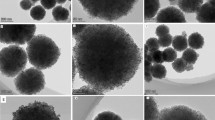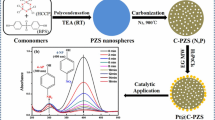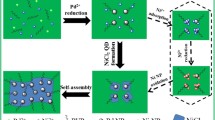Abstract
We have developed a facile three-step fabricating procedure whereby uniformly distributed and highly catalytically active Pt nanoparticles (NPs) were anchored on the superparamagnetic and catalytically active CuFe2O4 submicrospheres to form core-shell CuFe2O4@Pt nanocomposite catalyst. The as-prepared CuFe2O4 and CuFe2O4@Pt catalysts were characterized by transmission electron microscopy (TEM) and high-angle annular dark field-scanning transmission electron microscopy (HAADF-STEM), X-ray diffraction (XRD) and X-ray photoelectron spectroscopy (XPS). Their catalytic properties for reduction of [Fe(CN)6]3− to [Fe(CN)6]4− by S2O32− were comparatively studied. The results indicate that the inherent catalytic performance of CuFe2O4 can be improved dramatically when Pt NPs are homogeneously dispersed and firmly immobilized on its surface. The remarkably enhanced catalytic activity is mainly ascribed to the excellent catalytic performance of noble metal Pt.

Schematic diagram of fabrication of core-shell CuFe2O4@Pt.
Highlights
-
A facile three-step fabricating procedure is demonstrated to fabricate CuFe2O4@Pt NPs.
-
CuFe2O4@Pt exhibits superior catalytic efficiency to CuFe2O4 for reduction of [Fe(CN)6]3−.
-
The enhanced mechanism is due to the excellent catalytic activity of noble metal Pt.







Similar content being viewed by others
References
Zhu M, Diao G (2011) Synthesis of porous Fe3O4 nanospheres and its application for the catalytic degradation of xylenol orange. J Phys Chem C 115:18923–18934
Hudson R, Feng YT, Varma RS, Moores A (2014) Bare magnetic nanoparticles: sustainable synthesis and applications in catalytic organic transformations. Green Chem 16:4493–4505
Zhang D, Zhou C, Sun Z, Wu L, Tung C, Zhang T (2012) Magnetically recyclable nanocatalysts (MRNCs): a versatile integration of high catalytic activity and facile recovery. Nanoscale 4:6244–6255
Liu Y, Lv M, Li L, Yu H, Wu Q, Pang J, Liu Y, Xie C, Yu S, Liu S (2019) Fe3O4@SiO2/APTS/Ru magnetic nanocomposite catalyst for hydrogenation reactions. Appl Organometal Chem 32:e4686
Du W, Xia S, Nie R, Hou Z (2014) Magnetic Pt catalyst for selective hydrogenation of halonitrobenzenes. Ind Eng Chem Res 53:4589–4594
Long Y, Liang K, Niu J, Yuan B, Ma J (2015) Pt NPs immobilized on core-shell magnetite microparticles: novel and highly efficient catalysts for the selective aerobic oxidation of ethanol and glycerol in water. Dalton Trans 44:8660–8668
Gao Y, Chen B, Li H, Ma Y (2003) Preparation and characterization of a magnetically separated photocatalyst and its catalytic properties. Mater Chem Phys 80:348–355
Bai S, Shen X, Zhong X, Liu Y, Zhu G, Xu X, Chen K (2012) One-pot solvothermal preparation of magnetic reduced graphene oxide-ferrite hybrids for organic dye removal. Carbon 50:2337–2346
Li M, Xiong Y, Liu X, Bo X, Zhang Y, Han C, Guo L (2015) Facile synthesis of electrospun MFe2O4 (M = Co, Ni, Cu, Mn) spinel nanofibers with excellent electro-catalytic properties for oxygen evolution and hydrogen peroxide reduction. Nanoscale 7:8920–8930
Ren Y, Lin L, Ma J, Yang J, Feng J, Fan Z (2015) Sulfate radicals induced from peroxymonosulfate by magnetic ferrospinel MFe2O4 (M = Co, Cu, Mn, and Zn) as heterogeneous catalysts in the water. Appl Catal B 165:572–578
Chen M, Mo L, Cui Z, Zhang Z (2019) Magnetic nanocatalysts: Synthesis and application in multicomponent reactions. Curr Opin Green Sustain Chem 15:27–37
Zhang Q, Yang X, Guan J (2019) Applications of magnetic nanomaterials in heterogeneous catalysis. ACS Appl Nano Mater 2:4681–4697
Li Y, Shen J, Hu Y, Qiu S, Min G, Song Z, Sun Z, Li C (2015) General flame approach to chainlike MFe2O4 spinel (M = Cu, Ni, Co, Zn) nanoaggregates for reduction of nitroaromatic compounds. Ind Eng Chem Res 54:9750–9757
Feng J, Su L, Ma Y, Ren C, Guo Q, Chen X (2013) CuFe2O4 magnetic nanoparticles: a simple and efficient catalyst for the reduction of nitrophenol. Chem Eng J 221:16–24
Goyal A, Bansal S, Singhal S (2014) Facile reduction of nitrophenols: comparative catalytic efficiency of MFe2O4 (M = Ni, Cu, Zn) nano ferrites. Int J Hydrog Energy 39:4895–4908
Guo Y, Zhang L, Liu X, Li B, Tang D, Liu W, Qin W (2016) Synthesis of magnetic core-shell carbon dots@MFe2O4 (M = Mn, Zn and Cu) hybrid materials and their catalytic properties. J Mater Chem A 4:4044–4055
Wang J, Yu B, Wang W, Cai X (2019) Facile synthesis of carbon dots-coated CuFe2O4 nanocomposites as a reusable catalyst for highly efficient reduction of organic pollutants. Catal Commun 126:35–39
Wang L, Hu G, Wang Z, Wang B, Song Y, Tang H (2015) Highly efficient and selective degradation of methylene blue from mixed aqueous solution by using monodisperse CuFe2O4 nanoparticles. RSC Adv 5:73327–73332
Zhao Y, He G, Dai W, Chen H (2014) High catalytic activity in the phenol hydroxylation of magnetically separable CuFe2O4-reduced graphene oxide. Ind Eng Chem Res 53:12566–12574
Guo X, Wang K, Li D, Qin J (2017) Heterogeneous photo-Fenton processes using graphite carbon coating hollow CuFe2O4 spheres for the degradation of methylene blue. Appl Sur Sci 420:792–801
Wang L, Bock D, Li J, Stach E, Marschilok A, Takeuchi K, Takeuch E (2018) Synthesis and characterization of CuFe2O4 nano/submicron wire-carbon nanotube composites as binder-free anodes for Li-ion batteries. ACS Appl Mater Interfaces 10:8770–8785
Ma S, Feng J, Qin W, Ju Y, Chen X (2015) CuFe2O4@PDA magnetic nanomaterials with a core-shell structure: synthesis and catalytic application in the degradation of methylene blue in water. RSC Adv 5:53514–53523
Manikandan V, Mirzaei A, Sikarwar S, Yadav B, Vigneselvan S, Vanitha A, Chandrasekaran J (2020) The rapid response and high sensitivity of a ruthenium-doped copper ferrite thin film (Ru-CuFe2O4) sensor. RSC Adv 10:13611–13615
Zhao C, Lan W, Gong H, Bai J, Ramachandran R, Liu S, Wang F (2018) Highly sensitive acetone-sensing properties of Pt-decorated CuFe2O4 nanotubes prepared by electrospinning. Ceram Int 44:2856–2863
Kumar A, Srivastava R (2020) Pd-decorated magnetic spinels for selective catalytic reduction of furfural: interplay of a framework-substituted transition metal and solvent in selective reduction. ACS Appl Energy Mater 3:9928–9939
Lin L, Cui H, Zeng G, Chen M, Zhang H, Xu M, Shen X, Bortolini C, Dong M (2013) Ag-CuFe2O4 magnetic hollow fibers for recyclable antibacterial materials. J Mater Chem B 1:2719–2723
Koley P, Shit S, Joseph B, Pollastri S, Sabri Y, Mayes E, Nakka L, Tardio J, Mondal J (2020) Leveraging Cu/CuFe2O4-catalyzed biomass-derived furfural hydrodeoxygenation: a nanoscale metal-organic-framework template is the prime key. ACS Appl Mater Interfaces 12:21682–21700
Chen Z, Wang L, Xu H, Wen Q (2020) Efficient heterogeneous activation of peroxymonosulfate by modified CuFe2O4 for degradation of tetrabromobisphenol A. Chem Eng J 389:124345
Nie R, Wang J, Wang L, Qin Y, Chen P, Hou Z (2012) Platinum supported on reduced graphene oxide as a catalyst for hydrogenation of nitroarenes. Carbon 50:586–5596
Panella B, Vargas A, Baiker A (2009) Magnetically separable Pt catalyst for asymmetric hydrogenation. J Catal 261:88–93
Toyao T, Kayamori S, Maeno Z, Hakim Siddiki S, Shimizu K (2019) Heterogeneous Pt and MoOx co-loaded TiO2 catalysts for low-temperature CO2 hydrogenation to form CH3OH. ACS Catal 9:8187–8196
Qiao J, Liu Y, Hong F, Zhang J (2014) A review of catalysts for the electroreduction of carbon dioxide to produce low-carbon fuels. Chem Soc Rev 43:631–675
Du L, Zhang S, Chen G, Yin G, Du C, Tan Q, Sun Y, Qu Y, Gao Y (2014) Polyelectrolyte assisted synthesis and enhanced oxygen reduction activity of Pt nanocrystals with controllable shape and size. ACS Appl Mater Interfaces 6:14043–14049
Du X, Luo S, Du H, Tang M, Huang X, Shen P (2016) Monodisperse and self-assembled Pt-Cu nanoparticles as an efficient electrocatalyst for methanol oxidation reaction. J Mater Chem A 4:1579–1585
Rizo R, Pérez‐Rodríguez S, García G (2019) Well‐defined platinum surfaces for the ethanol oxidation reaction. Chem Electro Chem 6:4725–4738
Nasrollahzadeh M, Sajjadi M, Iravani S, Varmam R (2021) Green-synthesized nanocatalysts and nanomaterials for water treatment: Current challenges and future perspectives. J Hazard Mater 401:123401
Dandapat A, Jana D, De G (2009) Synthesis of thick mesoporous γ-alumina films, loading of Pt nanoparticles, and use of the composite film as a reusable catalyst. ACS Appl Mater Interfaces 1:833–840
Narayanan R, El-Sayed MA (2003) Effect of catalytic activity on the metallic nanoparticle size distribution: electron-transfer reaction between Fe(CN)6 and thiosulfate ions catalyzed by PVP-platinum nanoparticles. J Phys Chem B 107:12416–12424
Yang W, Ma Y, Tang J, Yang X (2007) “Green synthesis” of monodisperse Pt nanoparticles and their catalytic properties. Colloids Surf A 302:628–633
Kalekar A, Sharma K, Lehoux A, Audonnet F, Remita H, Saha A, Sharma G (2013) Investigation into the catalytic activity of porous platinum nanostructures. Langmuir 29:11431–11439
Sharma R, Sharma P, Maitra A (2003) Size-dependent catalytic behavior of platinum nanoparticles on the hexacyanoferrate(III)/thiosulfate redox reaction. J Colloid Interface Sci 265:134–140
Li H, Cao M, Liu T, Cao R (2012) Activation energy of the reaction between hexacyanoferrate (III) and thiosulfate ions catalyzed by platinum nanoparticles confined in nanometer space. J Colloid Interface Sci 369:352–357
Cheng C, Wen Y, Xu X, Gu H (2009) Tunable synthesis of carboxyl-functionalized magnetite nanocrystal clusters with uniform size. J Mater Chem 19:8782–8788
Guo S, Dong S, Wang E (2009) A general route to construct diverse multifunctional Fe3O4/metal hybrid sanostructures. Chem Eur J 15:2416–2424
Hervés P, Pérez-Lorenzo M, Liz-Marzán L, Dzubiella J, Lu Y, Ballauff M (2012) Catalysis by metallic nanoparticles in aqueous solution: model reactions. Chem Soc Rev 41:5577–5587
Kun H, Chao G (2011) Graphene nanosheets decorated with Pd, Pt, Au, and Ag nanoparticles: synthesis, characterization and catalysis applications. Sci China Chem 54:397–404
Sanles-Sobrido M, Correa-Duarte M, Carregal-Romero S, Rodrıguez-Gonzalez B, Alvarez-Puebla R, Herves P, Liz-Marzan L (2009) Highly catalytic single-crystal dendritic Pt nanostructures supported on carbon nanotubes. Chem Mater 21:1531–1535
Acknowledgements
This work is supported by the Natural Science Foundation of Shaanxi Province (No. 2018JM2032) and the Key Research and Development Program of Shaanxi Province (No. 2020ZDLGY11-02).
Author information
Authors and Affiliations
Corresponding author
Ethics declarations
Conflict of interest
The authors declare no competing interests.
Additional information
Publisher’s note Springer Nature remains neutral with regard to jurisdictional claims in published maps and institutional affiliations.
Rights and permissions
Springer Nature or its licensor (e.g. a society or other partner) holds exclusive rights to this article under a publishing agreement with the author(s) or other rightsholder(s); author self-archiving of the accepted manuscript version of this article is solely governed by the terms of such publishing agreement and applicable law.
About this article
Cite this article
Ma, J., Liu, Y., Du, Q. et al. Pt nanoparticles anchored on bifunctional CuFe2O4 submicrospheres with improved catalytic properties for the reduction of [Fe(CN)6]3− by S2O32−. J Sol-Gel Sci Technol 105, 758–767 (2023). https://doi.org/10.1007/s10971-022-05963-1
Received:
Accepted:
Published:
Issue Date:
DOI: https://doi.org/10.1007/s10971-022-05963-1




